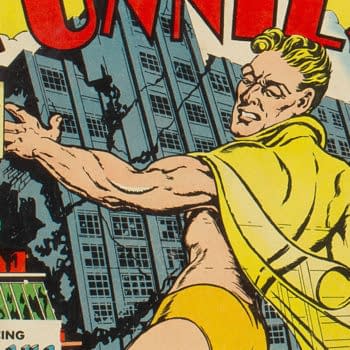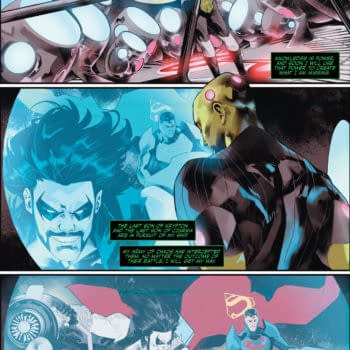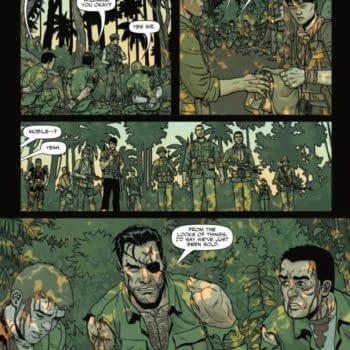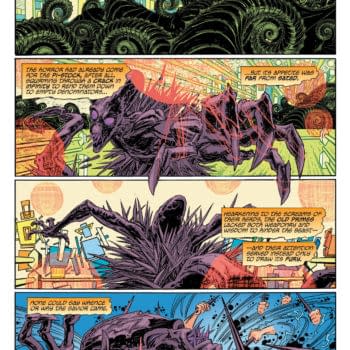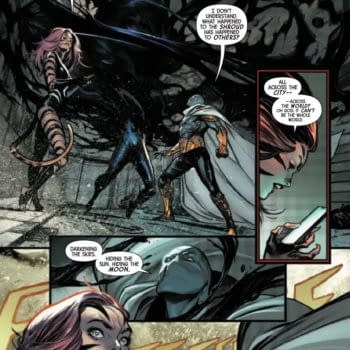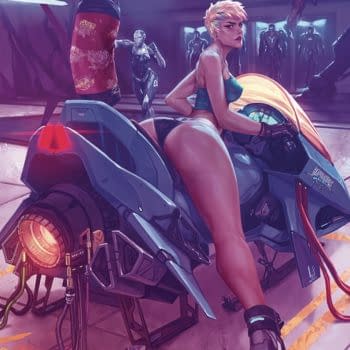Posted in: Comics, Recent Updates | Tagged: abe sapien, alien, aliens, cameron stewart, chuck palahniuk, colder, Comics, Daniel Chabon, dark horse, dave stewart, David Mack, entertainment, Fight Club 2, frank miller, guillermo del toro, jeff lemire, Joshua Williamson, joss whedon, Juan Ferreyra, matt kindt, mike mignola, mike richardson, Pastaways, Patric Reynolds, paul tobin, predator, prometheus, ridley scott, san diego comic con, scott allie, Sebastian Fiumara, Sierra Hahn, sin city 2, The Whedon Threeway
Discussions With Scott Allie – Dark Horse's Strategies For SDCC 2014, Defining Creator-Owned, Prometheus, Fight Club 2, And The Whedon Threeway
San Diego Comic Con is the untackleable beast, and yet for Dark Horse, they seemed to have a very clearly defined strategy this year that I found other journalists and fans remarking upon, from their full slate of announcements concerning "12 Creator-Owned" books before the con itself, to a massive and imposing presence on the con floor as well as a packed schedule of signings, to their intricate panel discussions. It was clear that they were the publisher who simply couldn't be overlooked in the clamor of SDCC, and the opportunity to hear directly from Editor-in-Chief Scott Allie about the concepts behind this full-scale assault on the con was not something I could pass up.
Likewise, the rest of 2014 and the coming year will continue to be marked by Dark Horse's large-scale SDCC announcements in a kind of three-pronged approach, hitting the licensed and interwoven Aliens/Prometheus line hard, bringing out the greatly anticipated Fight Club 2 as well as other creator-owned books, and continuing to support retailers and new readers through their incentive single-issue editions like The Whedon Threeway.
This may be the most imposing interview yet published on Bleeding Cool, and yet it developed into more of a discussion due to Allie's willingness to field comments and questions on subjects he is so clearly passionate about.
On Dark Horse's Strategies at San Diego Comic Con 2014
Hannah Means-Shannon: So, San Diego Comic Con. Is this the first year that you guys have laid out so many announcements beforehand?
Scott Allie: I think this is the first year we've done it in such an organized fashion. It's been a few years now that our strategy regarding big shows is to do all of our announcements leading into them or most of our announcements leading into them. Other media is making announcements so big, that it's hard to steal Robert Downey Jr.'s thunder from him, so everybody's got their eyes on the internet anticipating San Diego and New York Comic Con, so laying out those announcements ahead of time, so that before people come to the show and already know what they are looking for, has been a great strategy for us. For instance, announcing Fight Club 2 on the Monday before the convention allowed us to get the surprise out there and then make sure that everyone knew to come to the Fight Club panel on Saturday night. If we had surprised everybody with the news of Fight Club 2 on Saturday night, then the right people wouldn't have been there necessarily. So, we can promote the appropriate panels, signings, and events better if word is already out before the show, rather than try to do these really carefully timed things with sites down the minute with the on-site events. So the on-site events are meant to boost the signal, give some great photos for the internet, but the news has already hopefully stuck to folks.
HMS: Well, absolutely. And that's the trend and where things are heading. Because everyone knows that San Diego is so insane, and also the people who are coming to San Diego don't do it haphazardly anymore. They plan out their schedules for what they are trying to do because it's a huge show. Smart strategy.
SA: We've been working on that strategy for a while, and as other publishers adopt that strategy, we've been worried that there's more competition for the same early airwaves, but it worked out great for us this time.
HMS: Well, Rich Johnston and I are noticing a trend that the two weeks leading up to San Diego are in many ways as big as San Diego for that kind of news. For instance, Marvel really went that way this year, deciding to make three big announcements ahead of SDCC.
On the whole, did you all have fewer panels this year? It seemed to me that the signings and the floor, the physical presence of the creators, was a big deal this year, like you all had ramped that up a lot.
SA: Yeah. We had some good panels, but not an overabundance of panels. I feel like I, personally, did more than usual. I think you're right about the company. We have such a great location on the floor, a really great booth physically, and we work with a great company that's a great operator for our booth, so we make the most of the floor at the show, and that has been pretty effective for us.
HMS: I would say just from observation, that it was effective. I felt much more of a dominant presence from Dark Horse on the floor than I have in the past. Compared to other cons as well. There was a lot of "Wow" factor with the Dark Horse booth this year, including the huge signings, not just with Guillermo del Toro, but with the line-ups you had with lots of people at once for several hours for signings.
SA: Yeah, at one point we had a big line-up of Star Wars creators and people signing. It was pretty great. It was literally as many bodies as we could fit on that stage at that time. So, we've put a lot of thought into how to physically operate those kinds of signings. Probably the biggest one was the Sin City 2 cast, and we know how to run that stuff without a hitch these days, and knock wood for next year. But that's something you can do to really capture excitement in your booth that works well. We've built as much as we can around that.
HMS: And I daresay it's a different experience for fans because they are getting closer to the talent, getting more of that experience. Panels are great, but the creators are often kind of far away and you listen, whereas there is an excitement to being able to come up to someone, get your book signed, and give them an idea of why you like their work so much. It's more engaging.
SA: Yes, I think for some people, that's their unforgettable moment of their show. Those five seconds that you get with Mike Mignola or the whole team on the Star Wars books or a lesser known creator you're meeting for the first time, but he's sitting up there on the same stage that Frank Miller is going to be on, and you get to interact with him for a minute. You get to buy the book directly from him. Those moments are the reason why people used to go to San Diego, and still a big part of why they go to San Diego. We didn't used to go to San Diego to see Halle Berry or whoever, but it seems like it is often true these days. But with comics creators, there's a level of personal contact that you can get that's really valuable.
On Defining "Creator-Owned" and the Trend in Using the Term Among Publishers
HMS: So, there were twelve major creator-owned comics announcements before San Diego and relating to San Diego. I wanted to ask if you could explain a little bit about the prominent use of the phrase "Creator-Owned" in this case in your press for the con. I've spoken to you a little bit in the past about how most books at Dark Horse can be described as "creator-owned". Do you mean that as a difference from the licensed property books? Is that why it was used this year in that way?
SA: It's always been a big part of who we are. When Dark Horse started, everything was creator-owned. And over time, we've picked up licenses, company-owned stuff, and we have manga that kind of works on a different framework. Creator-owned has always been a big part of who we are. Other companies, particularly Image, but even some of those smaller companies, have trumpeted their creator-owned books in such a big way, and I found myself hearing retailers saying, "Yeah, Dark Horse doesn't do as many creator-owned books as they used to", and I thought, "Wow, man, we do tons!" But when I think about our focus in the last few years, we've got our huge creator-owned books like Brian Wood's The Massive and the whole Mignola line. People think of the Mignola books as something other than creator-owned, but in many ways it's the ultimate extension of creator-owned.
For many years, Mike wrote and drew every single book in that line, and over time it grew to other creators, but it remains the case that Mike created all this stuff, owns all this stuff, Mike has absolute control over all this stuff. It is creator-owned, but like many creator-owned things out there, it does use work for hire, like myself on Abe Sapien. You've got Brian, you've got Mignola, but in the last few years, we've done many books with new talent, with guys that we're trying to break in and make hits for. Like Paul Tobin and Juan Ferreyra, who did Colder. We've got Donny Cates, Jai Nitz, guys like that. We've been doing a ton of work with those guys. And so it felt weird to hear that we weren't doing as many creator-owned books as we used to when we are. But you're defined, I think, by your hits, by the biggest books out there. So, I feel we have been getting overlooked in the creator-owned department when we were pioneers in that department. We remain really strong there. So we wanted to make a lot of noise about the stuff we have going right now. Like the new Mignola book, Hellboy and the B.P.R.D, with him and Alex Maleev—that's a huge book for us. And it's going to be a big book at the end of the year, so we wanted to make a big deal about that and remind people that that book sits firmly in the field of creator-owned.
Then there's new stuff from Brian Wood, new stuff from Matt Kindt and Jeff Lemire. It's really exciting to have new stuff with those guys. Those are the kinds of creators we really want to back. We really want to be a part of what they are doing. We just looked at the schedule of what we had coming up, and over the course of the recent shows, we'd already made a big deal about the whole Aliens/Prometheus program we've been doing, so clearly that wasn't announcement to make for San Diego, though it would be something we would promote heavily at San Diego. Looking at what we had coming up, we thought, "We've got a lot of really cool creator-owned books from our biggest names and from brand new people". So, we felt that reminding people who we are and what we are all about was an important thing going into San Diego. We wanted people to see that this remains a huge focus for the company. And if anything, we are in a position to boost that up. The books with Matt Kindt and Jeff Lemire are huge for us and Fight Club 2 is a big one for us. They are books that operate on all these different levels and will make an impression at many different levels of the industry. So, we thought, "Alright, let's use the platform that San Diego gives us to really beat this drum and remind people that we want the creator-owned books here and we know how to do them. And we've been doing them for 28 years".
HMS: Absolutely. And it's funny how people have taken that for granted at Dark Horse. Even just the fact that you all had a massive, formative influence on Matt Kindt's career, which has now exploded so much, and Frank Barbiere, people who are really on the rise right now. When I was at the panel about collaboration that you all held at San Diego, I noticed just for me, as a fan, that my reaction was, "My God, look at these team-ups". It was those unlikely combinations that had a surprise and intrigue factor of having big names working on books together and even sharing tasks that you wouldn't necessarily expect right away, like Kindt doing the writing on Pastaways, though I know he's written many other things as well.
In the panel they talked about how that's freeing for them to be able to change up their roles and how that's been productive for them because they can't necessarily draw every book in the world in the time they have. But also the trend now is for these creator-owned guys to work across many publishers and even in many genres. And the impression I got is that Dark Horse is really throwing these doors open so that this is a place where they can bring these projects that are on their minds, that they want to do, but they aren't sure how to find a place for them. And that you all seem to be the encouraging factor, giving them that opportunity to go ahead with these projects.
SA: Yes. And when you're dealing with something like Pastaways or Fight Club, sometimes the writer or the artist needs help figuring out the overall framework. Like Chuck Palahniuk is new to comics, Matt Kindt obviously isn't, but tackling a new creator-owned comic with another artist was a new thing for him, and fortunately he has an editor here at Dark Horse, Brendan Wright, who he really trusts and has a great relationship with, and the company as a whole is really behind Matt Kindt. Mike Richardson is a huge fan of Matt Kindt. So he knows that he's got a publisher that can put together a massive Star Wars program and can put that same energy behind a creator-owned book where he's not going to do all the work himself. We can give him the freedom and the support to do a creator-owned book that he wants to do, but we can also give him the support to help him with the parts that he doesn't want to or doesn't have time to do himself.
HMS: That is actually a really good point. That might be a massive difference between working on a creator-owned project on your own versus with Dark Horse. A lot of creator-owned work has to be totally produced beforehand, and whoever is in charge of that project has to be the business-person and organize the steps of the process, make sure it's tidy and complete, and then submit it to a creator-owned publisher, and that can take an immense amount of time and effort, and may not go anywhere. Whereas Dark Horse has the support structure to guide people through that process, and as you said, do some of the lifting that otherwise might slow things down or might mean it never reaches fruition.
SA: Yeah, I don't think we have any editors here, though I may be wrong, who only edit work for hire stuff without also doing some creator-owned stuff. We probably have a couple people who only do creator-owned, but it's a mistake for us, and a mistake for everyone to perceive a total firewall between these different kinds of books. The way that I've worked on the Hellboy books over the years is very similar to the way I've worked on the Joss Whedon books over the years. And there are similarities to how we tackle the video game stuff and the Star Wars stuff, and one by one, these creator-owned things. And whether it's something like Fight Club, which is complex and has some of the elements of work for hire, because the artists are work for hire on Fight Club, or The Goon, where it is all Eric Powell, it's still giving a level of support and thinking about the overall project and the long-term publishing strategy that a book like The Goon and a book like Fight Club requires. Saying up front, "This is how to publish a comic in the direct market, and how to publish in the book market".
HMS: Well, that book market aspect is a really good point, too. That's, of course, a big subject of complaint and discussion, that comics publishers don't know how to handle the book market and make sure those graphic novels are in Barnes and Noble and libraries etc.
SA: We were pioneers in getting books into the book market. One thing about Dark Horse is we really push the whole trade paperback thing. Everything gets collected. We were the first publisher to really push that and do that, and make that effort to move into the book market. And we've changed bookstore distributors a number of times because of it, trying to figure out the best way to do it. We're currently with Random House and we feel like the sky's the limit with Random House. They have this down to a science. They've been doing bookstore distribution so long that they basically invented it, and we are really pumped about being able to get graphic novels out in a way that we've never been able to do before. We really feel like we're on the brink of something amazing with Random House for bookstore distribution. It's going to be really beneficial for programs like the Mignola books, and with Fight Club, we're going to be able to reach further than we've ever done before. What Random House is able to do with Avatar, with The Goon, is really going to redefine how we can succeed in that area.
HMS: We're talking business a lot, but it's very interesting stuff. On a side-note, The Fifth Beatle—you guys did an amazing job getting that into various places, getting that into bookstores as well as comic shops. And lots of books have been getting up there on the New York Times Best-seller list, which is an indication that books are being held on various platforms for readers. And of course, congratulations on the Eisner Award this year on The Fifth Beatle.
SA: Vivek Tiwary is an amazing promoter. He's been an incredible ambassador for that book. He believed in it. He put everything in his life behind it. He really was unique in his ability to get that book out to everybody and that made him a great partner for Dark Horse. And his Eisner speech was so heartfelt. He's like that all time—every conversation with Vivek is like that.
HMS: That highlights something else. In creator-owned books, at least one member of the team, if not several, ideally need to put themselves forward as the "voice of the book", someone who's reaching out and helping promote, getting people's attention on the book. Because it's a crowded market for creator-owned in a way, though it's a great time for creator-owned. But I would say that when that couples with Dark Horse's ability to do PR and promote the books, that's going to produce an even better result. I would say, from my experience, that the amount of energy you all put into promoting these books is another beneficial, drawing factor to bringing a book to Dark Horse. You're not having to carry that promotional weight all by yourself.
SA: Exactly, yeah. We have a very complex marketing team. We have people focused on social media. I'm sure every company does. But we've got a really big staff and they build really good relationships with creators. I think it's probably true of all of the bigger companies, but we don't leave the creators to do it all on their own.
HMS: Well, I would say just from my professional experience, that you all are actually more active than some. Your editors put themselves into that process too, which is admirable, in my opinion.
SA: I think we're lucky to have that. We have a number of people in our editorial department who have come from marketing. Sierra Hahn is one of our lead editors and she was a publicist at Vertigo before I hired her to come over to Dark Horse. Jim Gibbons was at Wizard at one point, and he was in our PR department for years. Dave Marshall interned at Wizard. Spencer Cushing was in our marketing department for a few years before coming over to editorial. So, we've got a lot of people in the department here who have a real firm footing in marketing and see how marketing is a part of publishing. They see how it's all one thing. If we're not getting the word out about the book, it doesn't matter how much work you pour into it. Nobody will know about it. So they are pretty engaged, and a lot of them are really skilled at it. One thing about that, too, is that I think at Dark Horse we tend to have fewer number of titles per editor than at other companies. With most of us doing four or five books a month, we have a pretty deep connection to the material we are editing. Every book is pretty special to the editor working on it. And depending on the book, we are more or less creatively engaged in it. In my experience, when I was working with Sergio Aragones, he turned in the work, and it was great, and it was done, and it was less involved with hands-on editing like I've got to do on a Buffy book.
There's this real spectrum of editorial engagement per title, but you still have this really strong sense of connection to the creator that you're working with and the effort of putting a book through production and all of these things. You're really married to it in a way that maybe you aren't if you're having to jam out 10 books a month. I'm sure the connection is deep there, but it's got to be spread a little more thin with so many books under a single editor.
On Prometheus #1, an "Illustrator" Style and the Aliens/Prometheus Line
HMS: Thank you. Let's talk about some upcoming books, like Prometheus and Abe Sapien, and Fight Club 2. I managed to see the preview book that was given out at SDCC for the Aliens/Prometheus line.
SA: Well, originally, we started work on the whole Prometheus program quite a while ago and we had that group of writers meeting at my house. At one point, the whole program was scheduled to launch in May. It was going to launch in May or June. We were planning on having a hardcover edition of all four first issues that was going to be an exclusive at Comicon. But we wound up just doing that ashcan because we were working on the story, we had the scripts approved, we had the outlines approved, we had a couple of issues fully drawn, one issue colored and lettered and ready to go back in January or February. But then Ridley Scott and Fox came back and said, "We need a big change to the central premise of the whole story. It needs to change radically".
HMS: Oof. God.
SA: It had already been approved a couple of times. It just so happened that we had all the writers over to my house when we got that note from Fox. Around 6:30 or so everyone walks in. Joshua Williamson was the first one to get there so I sat down with him with this one page memo we'd prepared and I said, "Sit. Read it. Let's talk". And as each writer showed up, we gave them a drink and a copy of the memo. And we discussed it and all sat around the table swooning and everybody reacting in their unique way. And eventually we pulled it together and came up with a new story and started from scratch. That's how the book moved from June to September. That's why San Diego had an ashcan rather than a hardcover.
HMS: The joys of licensing. However, if you guys hadn't had experience with things like that happening in the past, you wouldn't have been able to pull it back together so quickly!
SA: Yeah. It was our experience, but also the fact that we'd built a pretty great team. I wonder how it would have been if my different writers were scattered across the country or across the globe and I just had to set up a conference call or send out a bunch of e-mails. But because we had started this project by having everybody face to face and through the course of working on it done some team-building that I think will last with us all for years to come, nobody could have quit. I worried about it. I wondered, "Is it going to be this one, or this one? Which one of these guys is going to say, "Wow, this sucks. I'm out". I was worried someone was going to do that, but we were all in this together to the point that no one was going to say, "This is too much trouble for me, I'm out".
Because they would've looked around the room at all the people they'd been collaborating with for months at that point and didn't want to walk away from it. So we fixed it. And I think, unanimously the five writers all feel that we have a better story now because of it. A lot of it survived, but a lot of the central premise was cracked in half. So, knowing each other a lot better at that point, knowing the characters, knowing the kind of story we wanted to tell, we kind of stripped it back to the bones and said, "Ok, what is this thing?" And I think the reason why we did it even better the second time around is because we had a certain amount of practice together. And we trusted each other, knew how to listen to each other. So at that first meeting, the meeting where the memo was handed out, that meeting wasn't the most productive meeting I've ever been in. We had a really good dinner and we looked at each other a lot, and we talked about some stuff, and we started getting the ball back rolling, but I think it was the next meeting that the ideas we came up with at the memo meeting started shaping up into a better form.
HMS: Well, people needed some decompression, no doubt.
SA: There was a lot of horror, yeah. Because it was like, "We've done this work and it's just gone". We had an issue of Prometheus lettered and colored. And it was just like, "Shred it!" Literally, I had a printed out stack of 12 copies of it. And I looked at them and thought, "This is all it's ever going to be. These print outs with binder clips holding them together. This book's going in recycling and eventually will be a new book". And my son saw what I was doing and he asked if he could keep one. He read it and has it in his room somewhere. I said, "You're going to be one of the only guys who reads this version of Prometheus #1". It was an experience for sure.
HMS: What you're conveying is a certain amount of grief for a creative effort lost, time lost, what it could have been. Having looked at Prometheus #1 that I've seen, the new one, and also the ashcan, I also got a really strong sense of cohesion in the artwork among the books. That's not to say there wasn't diversity there. But the biggest impression I got from it was that there was this tone of organic focus and focus on human beings that really surprised me and that gave it a different look and feel than whatever other science fiction books might be out there at this time. And it felt more, weirdly, like a creator-owned series for that reason. It was unique in its art approach.
SA: With the art approach, we really didn't want a house style. We didn't want to say, "This is what the Aliens and Predator books look like". What we did want was for there to be similarities that work for us, the writers and the editors on the team. We wanted something more, and these terms can be meaningless but they mean something to me, we wanted something more like an illustrator rather than classic superhero comics. We didn't want the traditional penciller/inker/colorist breakdown. We wanted it to feel a little different, a little more like illustrators. And the first two artists that we hired were Juan Ferreyra, who is drawing Prometheus, and Patric Reynolds, who is drawing Aliens. And for me, both of those guys approach the work to a degree like a painter. Juan does fully-rendered, full-color digital work. Patrick does very traditional, as in on paper, pencils and inks. But it has this real Kent Williams, Jason Alexander painterly feel to it. And those guys look nothing alike, and yet there was a spectrum there that made us think, "Ok, if Juan and Patrick are the way we are approaching this, then that's what we mean by "illustrator" and by "painterly". Where else can we go?"
And that's what led us to Ariel Olivetti and Chris Mooneyham, who are also very different from one another. But it felt to us like it made some sense. Each book is going to have a strong, separate identity. We didn't hire Juan and Patrick and then say, "Now let's get carbon copies of these two guys". And Ariel is a guy who sometimes has a lot of digital stuff in his work and sometimes it can look very digital, but on this he worked in a style that was more organic and looks more hand-done even though it's digital. And Dave Stewart is coloring, and he does it all digitally, but it looks more organic than a lot of the oil painting you'll see out there.
HMS: There's a texture.
SA: There are brushstrokes. There's a way of thinking about color that's somewhat true to classic painters.
HMS: It's interesting, though it's a strange thing to say, but I feel that I can always tell a Dark Horse book from the colors. You've always had a focus on looking at the quality of that and making sure it harmonizes with the story, as well as a focus on mood. And when I look at these books, I do see a kind of sympathetic thread through the different books and it does somehow link to the color, though I'm not sure how to analyze it further.
SA: Well, actually, part of that is because Dave Stewart does live in town here, and he's one of my best friends. We worked with Dave to do something with that. Dave actually came up with color notes and gave us a kind of "color Bible" after reading some of the original outlines. That got given to all of the different color artists and cover artists and it wasn't something so slavish that it tied their hands, I hope. But it did give them certainly guidelines. It gives you a certain cohesion. It was something Dave worked out initially with sheets of notes and examples, and Juan kind of expanded on it in certain ways because Juan was right out front there. Even though he's in Argentina, he worked with us pretty closely. He's a guy I've worked with so closely for so long, and Daniel Chabon and Paul Tobin have worked closely with him. So even though he was the one key player who was not Portland-based, he was involved in designing a lot of the stuff. And because he does full-color work, he was one of the first guys to execute a lot of Dave's ideas.
When Patrick Reynolds and Juan were kicking the designs back and forth on characters, Patrick's designs were in black and white, and Juan's were in full-color. So a lot of the color work was getting laid down at the earliest design stage. So, there's going to be a lot of cohesion. We have this one section of our internal website that's just full of reference for this project and editors draw upon it for the artists. Because the stories are so interconnected in various ways that we needed a visual cohesion or things would have spun apart. We needed the ships to be designed, and the interiors to be designed. There are so many ways in which one issue bounces off the others and a lot of attention had to be paid to it. The editors, Philip Simon, Brendon Wright, and Daniel Chabon, the main editors on the four-issue mini series get together once a week and try to catch anything that needs to be made consistent. It's an elaborate process for sure.
On Abe Sapien #16 and Abe's Past and Future Roles in the Mignolaverse
HMS: Let's move on to Abe Sapien #16. Well, first of all, the artwork is amazing.
SA: That's Sebastian Fiumara, "Seba". Working with Seba, and our South American identical twin faction at Dark Horse is growing and amazing, but the Fiumara twins are so great to work with. #16 and #17 are a two-parter that Sebastian is doing. Once again, we have Dave Stewart in there. One of the things that I wanted to do with the town in question that Abe goes to was to have a lot of graffiti. I wanted the town to have a lot of graffiti. In part, because I was trying to elicit some of the tone of this bizarre and disastrous Bob Dylan movie, Masked and Anonymous. I wanted to get some of the feel of the towns we saw in that movie, so I asked Sebastian to cover the town in graffiti and he and Dave worked out a system of how they could do that using layers and colors to make the town look a certain way and give it more color. But it's the story of Abe returning to the town where he was shot a few years ago, in I think Guy Davis' final B.P.R.D story. He did a story where Abe got shot, went into a coma, and lay in a coma for a number of years. And during that coma, he was transformed into the new version of Abe, who is different from the classic version. And Abe's been running around the Southern states, and he finally arrives in the town where he was shot, trying to get some information and figure out what happened to him. He finds the town to be a complete disaster area.
HMS: So, loose ends. There are always threads and mysteries in these character's lives, left to possibly be explored later. Why at this point in Abe's storyline do you want to come back to this event in his past?
SA: Abe ran away from B.P.R.D. and he argued with everyone he met along the way, saying, "No, no. I wasn't running away. I'm looking for answers. But he wasn't really looking for answers because he wasn't doing anything to find answers. But after a little while of being called out for his BS, now he is finally taking stuff head-on and he is looking for answers. And so the first place he thought to go to really find answers was the place where his latest transformation began. So he's not ready to return to the B.P.R.D. and doesn't think he'll ever want to go back, but he can't just hide in the desert. Well, he's a fish and he'll die. But he needed to take some affirmative action to figure out what happened to him, and to disprove what everybody thinks, which is that he is tied to the changes, the horrible changes, that are going on in the world.
He had a dream recently where he was talking to Hellboy, because he knows now that Hellboy's dead. And he was saying, "Haha. Now with you dead, I guess people think that I'm the beast of the apocalypse". Hellboy says, "No, Abe. You're something else altogether". And that didn't really comfort Abe. Looking at the changes he's gone through and the terrible stuff that sprang out of Texas, he's gone back to that town to try to figure out what happened there. And he'll get very small pieces of the answers, but he will start to get more useful perspective on things and he'll find himself in a better position to act. He'll meet a bunch of interesting people. Some characters that John [Arcudi] and Mike and I talked about him meeting a while ago, and that'll set him on his path.
HMS: I got the impression from the conversations in this issue—and I'm always looking for this Biblical stuff—but they are using almost messianic language for him. These people are saying, "Oh, he's back. We knew he would come and help us". Based on that dream with Hellboy, Abe resists that savior role. He doesn't mind helping people and wants to. But anytime someone says, "You're a hero" or "You're really important", he seems to shy away from that. I guess his sense of failure over various things affects him. Is he being set up as a leader here?
SA: Well, usually when people talk about Abe as a messianic figure, they are not talking about a good one. There are a bunch of people, including this character Gene, who Abe finds in this town—who believe that Abe is a messiah of sorts, and have built this cult around him, to Abe's great surprise and horror. What they believe isn't anything Abe himself wants to believe. It's not so much that Abe wants to reject the role of leader or hero, it's that the particular version of leader or hero he's being cast as is terrifying. There was a character quite some time ago in a story called "The King of Fear", the climactic story in the Plague of Frogs arc, who said, "Your'e the next step in human evolution", or at least non-human evolution. And Abe said, "No. That's terrible. Of course I'm not". But a couple of other people are perceiving that, looking at Abe, looking at the frog-men, looking at what's happening in the world, saying, "You're unique in all of this. Clearly you have some major role in it". And that major role, just like with Hellboy, is not a role that Abe embraces.
Mike's whole mythology that he's built into this world of characters is very Catholic, it's very Biblical. Those elements are a big part of Mike's inspiration as well as all the folklore stuff he's into. But there's a strong backbone of Catholicism to the whole thing, and there's a strong messianic thread that pops up in all these stories in various ways, but it's never good. Hellboy and Abe in particular are presented with these destinies, but they are not destinies about saving mankind, not about leading mankind to paradise. But they are usually a little darker than that, and these characters tend to try to reject them. It's interesting that Hellboy and Abe reject them in different ways. Hellboy says, "I'm not going to look at that". Abe is a little more active in his rejection of it and a little more neurotic about it. And that particular rejection is shoving him into the center of things. And the town Rosario, in this comic, is a little bit of the beginning of getting the pieces of that puzzle.
The important thing with what Mike's doing with all of this, and I think it's been one of the things that's made his work compelling from the get go, is that the reader always has a strong sense that it's leading somewhere. The reader may not always know where it's going, but they have the sense that it's building to something. And Mike, John, and I feel that now more than ever. It's very imminent where it's leading, and things are coming crashing down on top of these guys. The payoff that's been building for some of these guys for 20 years, it's getting stirred up into a real frenzy in a way that's fun. And I think the people who have been reading the books for awhile and the people who have gotten on board with the books recently and have gone back to read the older stuff, they know that there's a payoff. We're not just spinning our wheels with this stuff. It is one story. There are no reboots, no reset buttons, just one story here being told. And it pays to read it closely because there are hints from the very beginning that are being paid off right now, and it's just going to start getting closer over the next few years.
HMS: Well, I'm no expert, but I've read a majority of the Mignola books. And just looking at the Abe Sapien series, I always felt that I was being prodded to keep an eye on him and his significance. He wasn't just a cool, interesting character because of how he looked or because he had an interesting way of thinking, but because his role was going to be more crucial than that. It's satisfying to see a series dedicated to him and see these stories coming out where things are becoming clearer that he is important.
On Fight Club 2, Chuck Palahniuk's Sponge-like Mind and Creating Comics Vs. Prose
HMS: Can we talk more about Fight Club 2?
SA: Fight Club is one of the most exciting things I've ever gotten to work on and I cannot wait to get it out there in the world. Chuck Palahniuk put us in the interesting position of giving us all 10 scripts completed. They are going to evolve over the course of things, but it's amazing to have a work like this. For Cameron Stewart to be working on layouts for issue #1 with the script for issue #10 in his hand means that he knows exactly where it goes. There's a level of visual complexity that we all want out of the series that's only possible to do because we do know exactly how it ends. The ending has already changed once through the course of meetings, but we do know. Chuck happens to live in the Portland area, Cameron came and lived and worked here for a couple of months, Dave Stewart lives here, the letterer came out to spend a week, and David Mack [the cover artist] lives here in town, so we've been able to get everyone together and jam on ideas that would have been hard to execute just by e-mail. Cameron lives in Germany these days, and the time difference alone affects how you interact creatively. So having him out here for 10 weeks this summer was phenomenal.
HMS: Well, speaking candidly, just looking at the novel and then thinking about how this comic is going to take shape, this is a demanding text. This is something that's not going to breeze into comics format easily. At the same time, there are things going for it that make it a natural choice for a comic, especially all the differences in psychological perspectives and how you render them. But I can see that it's going to take careful decisions like how much prose to use per panel and per page, and how to show without having to tell some of it so as not to overburden the reader. But Chuck said in the collaboration panel at San Diego that he really liked putting this in comics format because he sees a very basic, surface symbolism that he's going for in his stories that he thinks that comics can tell very well without going to overly, obsessively deep psychologically. He feels you can leave things unexplained and let the reader put things together, which is something he seems to want.

And there's a surreal quality to Chuck's writing as well, and I think that comics can do surrealism better than any other art form because it is a manufactured reality. Every single drawing, every single panel of a comic is a completely fabricated reality. Somebody drew it. And there's this great borderline that comics sit on between fully realizing something visually, which film does, and leaving a lot to be filled in by the reader, which prose does, and comics can do as well because of the varying level of detail in the art. And that's the thing about Cameron, because there's a level of abstraction to his art which you might call "cartoonyness" that leaves a certain amount of work for the reader to do. It's like Magritte, "This is not a pipe". It's not a pipe, it's a drawing of a pipe. This is not Tyler Durden. It's a drawing of Tyler Durden. Tyler Durden is not really there at all. There's this way that comics can do surrealism. What Chuck does isn't exactly surrealism. What Chuck does isn't exactly anything else, not satire, not parody, but funny as hell. But it's tearing down things that are out there in the world, and I think comics, and I think Cameron, David Mack, and Dave Stewart can do that in a way that perfectly complements what Chuck does.
HMS: In the thing that I've seen, the as of yet unpublished "tryout" that Cameron did from pages of the Fight Club novel that didn't make it into the film, I noticed something that Cameron was doing that was incredible. He was obscuring parts of the face, especially for Tyler. And that just creates a more paranoid feeling because the reader keeps wanting to turn their head to see what his expression is. It's so enigmatic because the beats are moving pretty quickly so you don't have time to dwell on that for very long, but it does give the sense of the narrator being a prisoner and only getting these limited shots, like a prisoner in his own mind. It's very interesting the pitch and tone that it creates. Cameron's also definitely leaving blanks to be filled in. Like there's a beat between each beat where you're standing in that zone and it's even more tense for that reason.
SA: You got it, especially that first part about covering the face. That was a three hour conversation at Dave Stewart's house. One of the words that Chuck has used most in talking about the aesthetics of the comics amongst ourselves is "occlusion". We've talked a lot about occluding information. Going back to Chuck's prose, he gives you what he gives you, and he holds back what he's going to give you later. It's really fascinating. He really leaves so much mystery between the lines in his prose, and that's a big part of what we're doing in the comic. We've worked out all these storytelling devices for how we're going to hide information and reveal information. It's a big part of how this particular narrative needs to play out. So, yes, hiding a face, covering up a face, sometimes covering up a word balloon, is part of the narrative trick that we are trying to use here, and these are things that we sat around brainstorming with the artist, with the letterer, with the colorist, to figure out how to do this in comics. How do we do some of what Chuck does in his prose in a unique way in comics?
I think Chuck as well as [David] Fincher are what we think of as "formalists". They don't just use their art form to tell just any story. They use their art form to tell a story that only their art form could do. If you read the Fight Club novel and you see the movie, in a way the movie is so faithful to the novel, except the end, but it does things that only a film could do because the novel does things that only a novel can do. And you will see that Fight Club 2 does things that only a comic can do. And he has written things that wouldn't work in prose, and I don't know how they'd work in film, but we've worked together as a group to make it as uniquely and necessarily a graphic novel as Watchmen was. I'm a big Alfred Hitchcock fan, and Hitchcock I think was maybe one of the first filmmaker, as well as Orson Welles, who explored what you could uniquely do with film, and he told stories that he thought would make best use of the form he was working with. And I love that about Chuck's prose. And I love the way in which he has just plunged himself into comics. He refers to himself as a neophyte and is learning about comics from us, but he has a brain like a sponge and he's soaking it all up.
We had an appointment at one point at Things From Another World, the retail chain that Mike Richardson owns, and my wife works there too. Before making a final decision about Cameron on the book, though we had really already decided, we made an appointment to meet at TFAW one day so he could really see what was out there. And we were going to spend as much as time as we needed to pick through the shelves and talk about all the possibilities out there. And it was really informative for me to see what he thought. I got there a couple minutes early, and he was already there, and I later found out from the clerk that he'd been there an hour before I got there to go through the shelves himself.
He went through and he studied up, then he and I went through and we talked about Umbrella Academy and we talked about Francesco Francavilla, and we went through all these different artists like Ben Templesmith, and so many different styles of art as well as the pros and cons for what he was going for. And it just kept coming back to what we would get from Cameron. All the guys he responded to most positively were guys like Gabriel Ba and Cameron. He really liked Becky Cloonan and stuff like that for very particular reasons. And it became even more clear to me that Cameron was the perfect choice. Chuck had read Sin Titulo, and that helped him understand what Cameron could do. We talked through covers, letters, colors and his aesthetics were forming on the fly as we went through all the stuff. And we got the team on the book that maybe if Chuck had spent years drawing instead of writing prose, this was the book that I think he would have done.
HMS: It's like you watched him in high-speed evolution for a couple of hours.
SA: He's a quick study and he wants to learn, and that's up front. It's great to have a guy who ultimately is calling all the shots, because anything he does or doesn't want to do we are going to do the way he wants to do it, but it's a great experience when that guy who by contract has absolute say over everything we are doing on these books just wants to learn. He wants to see what we bring to the table. That's part of what makes it so rewarding for Cameron and Dave Stewart because it's a team effort.
HMS: And he's not making those prose writing blunders of trying to ask you all to do things that are not natural to comics. I imagine high-powered writings occasionally do that when they come into comics.
SA: It's funny. One day we were going over scripts and we realized that Cameron had forgotten a panel. I assumed that Cameron had intentionally combined two panels, but he said, "Oh, crap. No, I left a panel out". And so we talked about how to make that work. And Chuck said, "Well, what if I just cut some of the narration there?" We were all feeling like his prose was sacrosanct and the last thing we wanted to do was jettison some of his writing because Cameron left a panel out, but Chuck said, "No, I really like the way the page is laid out. So, what if I just do this?". He took his pen and just started slashing phrases and lines from this one caption. And then we said, "No, that was the wrong panel! You cut the stuff from the wrong panel". And he said, "Oh, ok", and he went in and started slashing from another panel. He just reduced a level of texture on the prose to make sure that the art had room to breathe and so you got that perfect synthesis of words and pictures. He's not putting the words ahead of the images because he gets that that is not the best way to do a comic.
HMS: In the collaboration panel, Chuck mentioned that, and Cameron jumped in telling the story, but you kind of got the impression from the look on his face that Cameron was thinking, "This is what made me really feel emotions for Chuck, that he did something like that". (Laughs) There was an emotional look on his face.
On The Whedon Threeway, Coming Soon To a Shop Near You
HMS: Well, lastly, let's talk about The Whedon Threeway, which is also coming up.
SA: We had done something kind of like this for Season 9, when we put the first issues of all four miniseries into a five dollar book that was a pretty good value compared to what comics usually cost. We wanted to do it again, and include Serenity. The goal with a thing like this is just to get as many copies out there and into peoples' hands as possible. So we decided to just charge a dollar for a 72 page book, jam-packed with stories. We cobbled together a new cover using a bunch of Georges Jeanty art because he's the only artist who has drawn all of those characters for us between Serenity, Angel, Buffy, and everything. We put it all together and got it colored in house by Dave Nestelle, a great digital artist. It's the first issues of Serenity: Leaves on the Wind, and Season 10 Buffy and Angel and Faith. Those first three issues in a single dollar book. With Buffy, over the years since we started Season 8, readers have come and gone, and we get new readers who are maybe younger and new fans of the show discovering the comics for the first time.
But as deeply into these comic book seasons as we now are, I know it can be daunting for readers to jump in. There are a lot of books. So, when we started Season 10, we really wanted to make it a good place to jump in for people who hadn't read Season 9. The Whedon Threeway was Joss Whedon's suggestion for a name, though it turns out he was kidding and we did it anyway. With the Whedonverse, how you can not buy 70 odd pages for a buck? We do these dollar reprints all the time, one dollar for a single issue, and for retailers we try to time them to support the trade paperbacks that are coming out. And that's what we are trying to do here. We're hoping retailers will take advantage of this one dollar Whedon Threeway to help get readers to give a shot at the Buffy and Angel and Faith Season 10 volume ones that are both coming out this fall, and Serenity: Leaves on the Wind hardcover that's also coming out his fall. Serenity had amazing sales, the mini-series. But I know there are a lot of Serenity fans out there who didn't pick it up. And if they are thinking of picking up the hardcover, this dollar comic is a great way to dip their toes in and figure out if they are into it.
Prometheus #1 is currently listed in Previews with item code JUL140052
Abe Sapien #16 is currently listed in Previews with item code JUL140123
The Whedon Threeway is currently listed in Previews with item code JUL140115





















